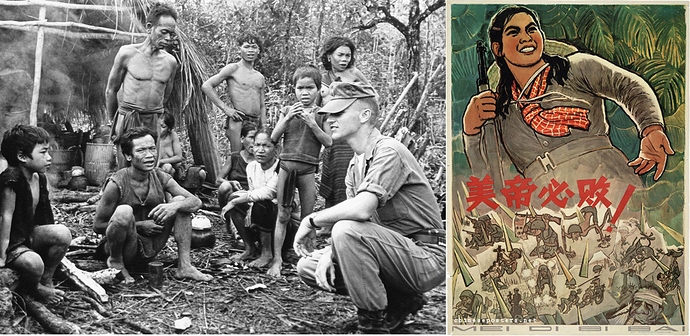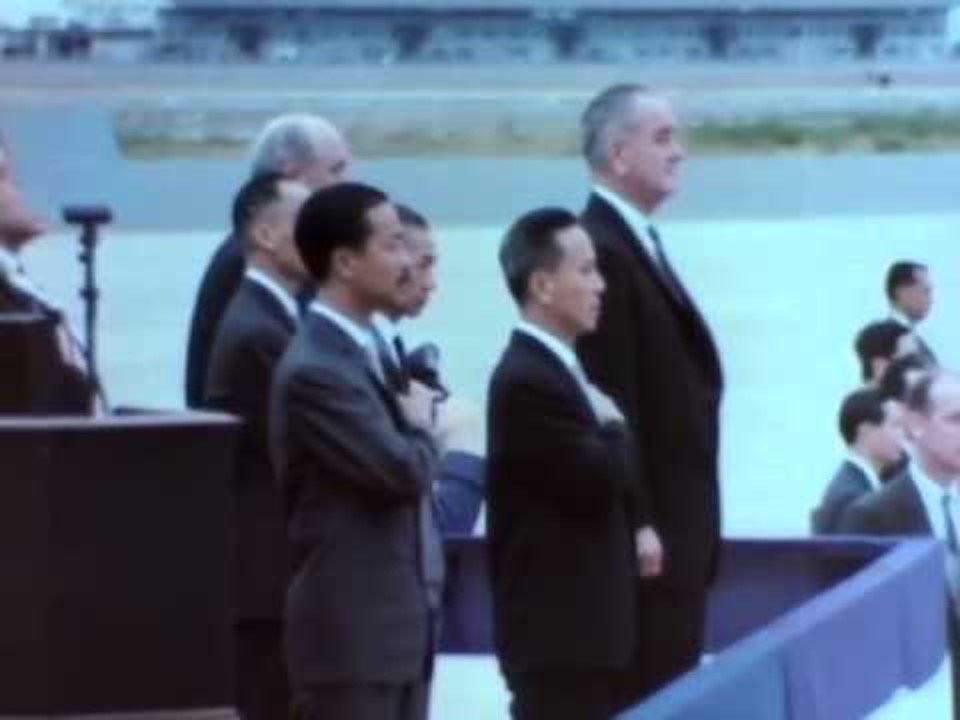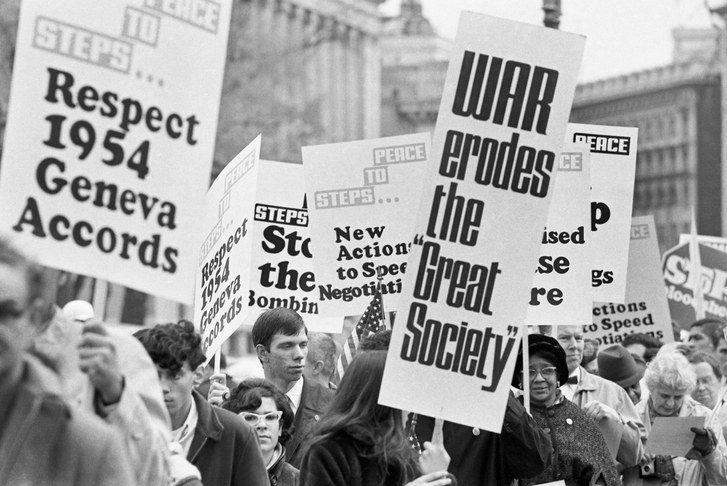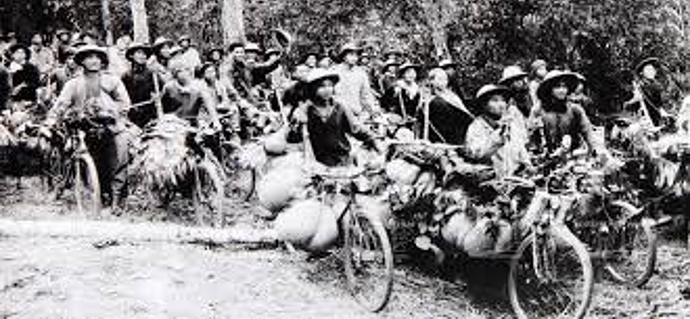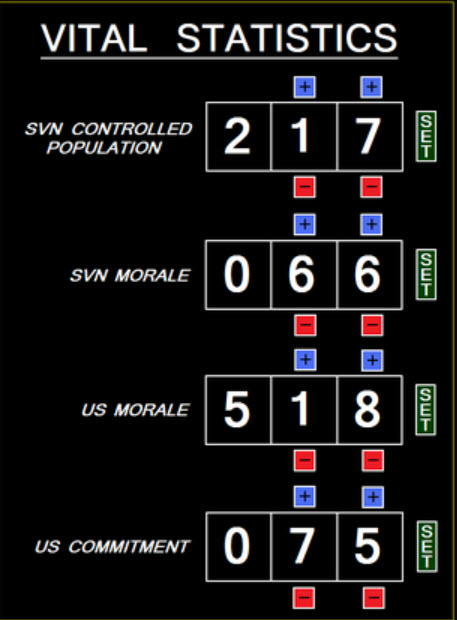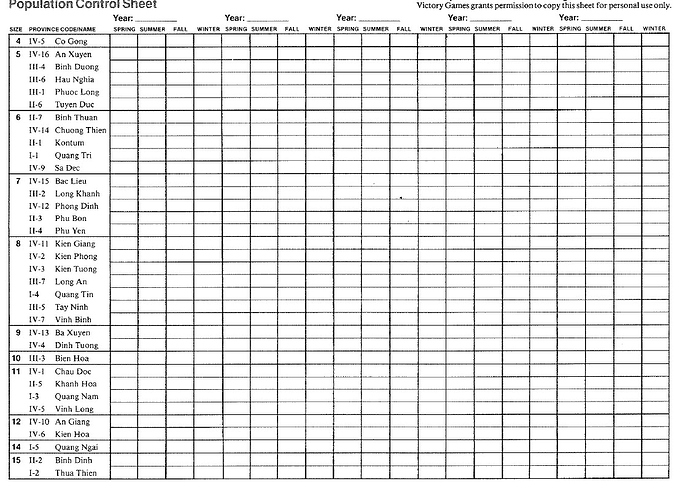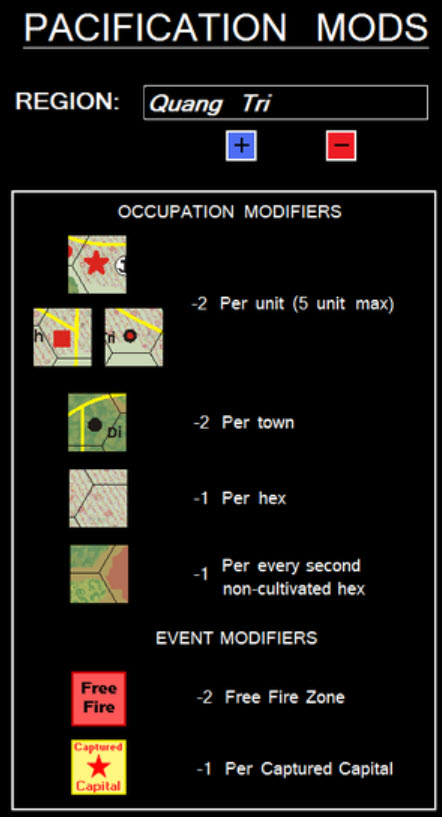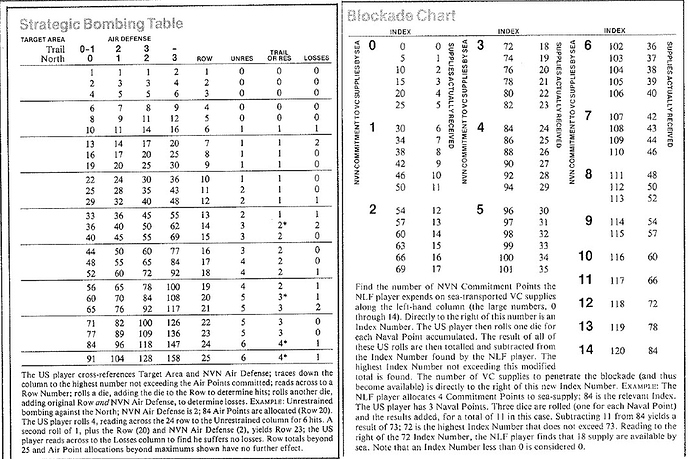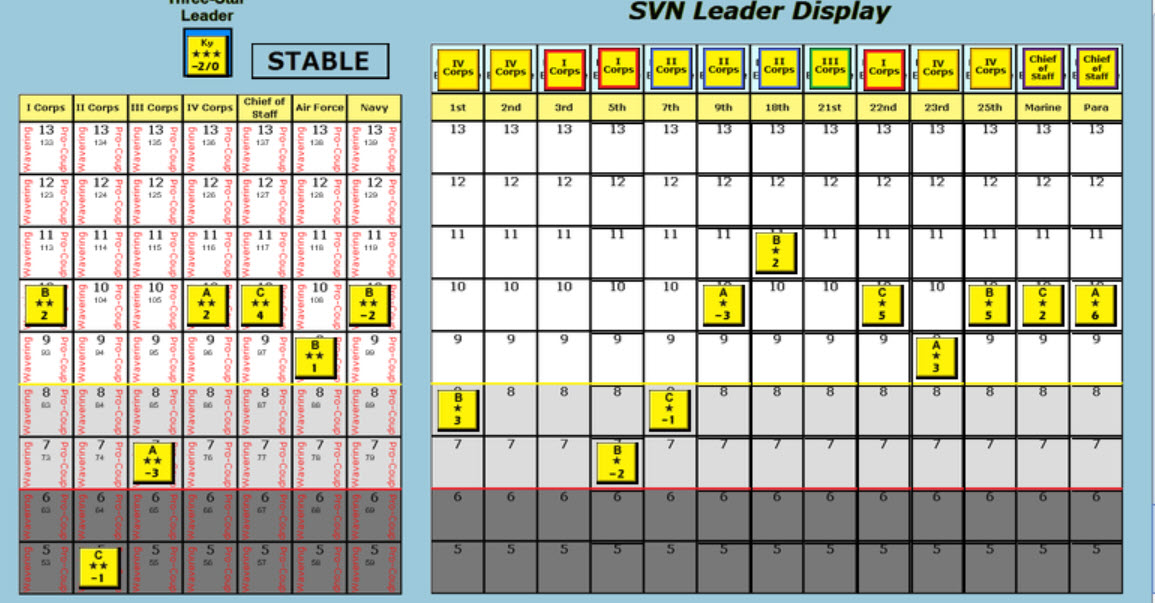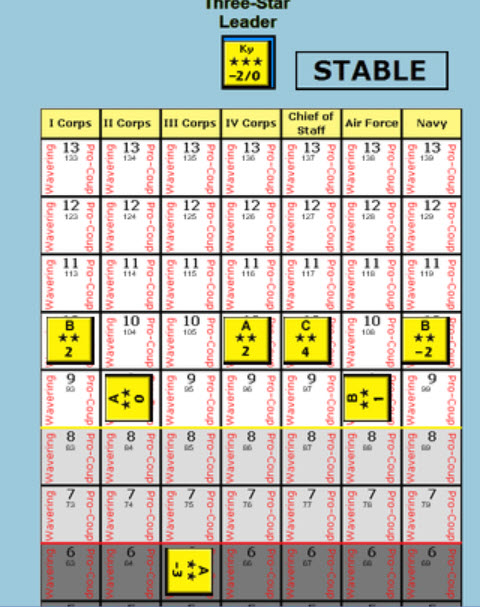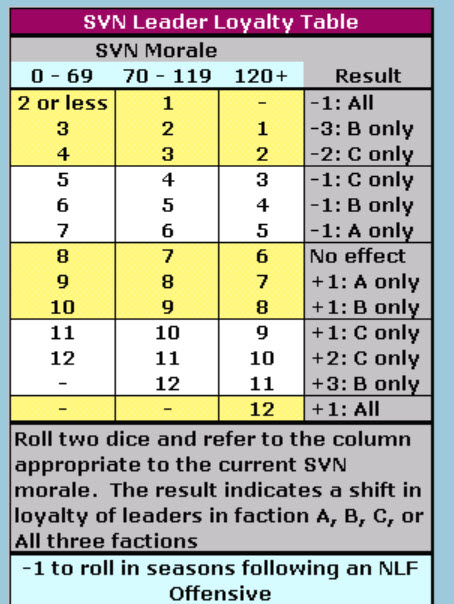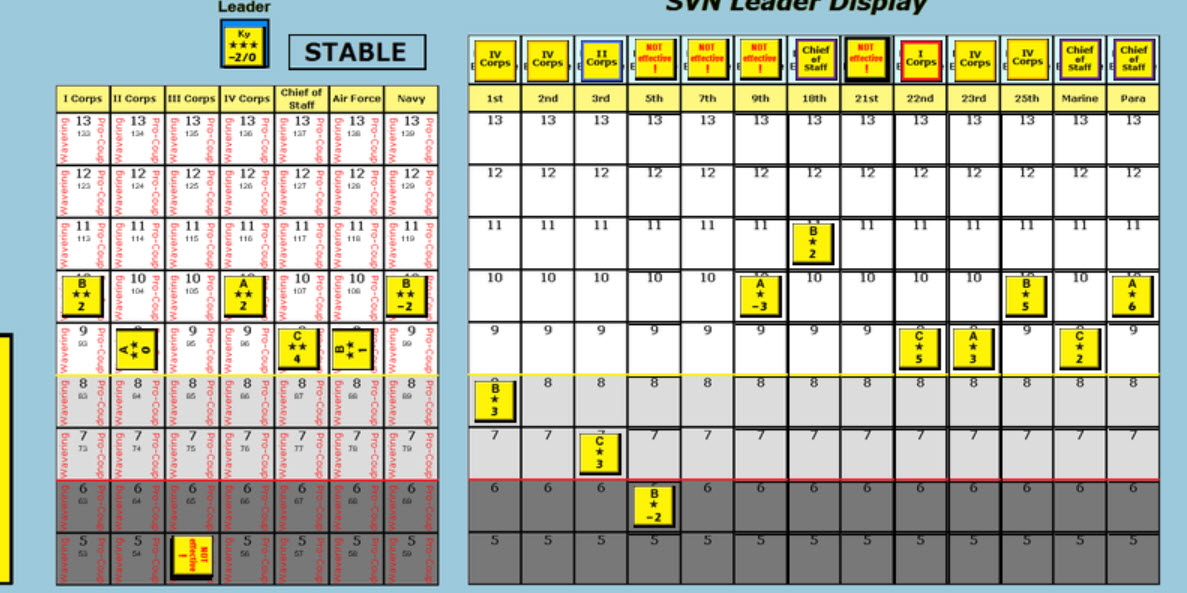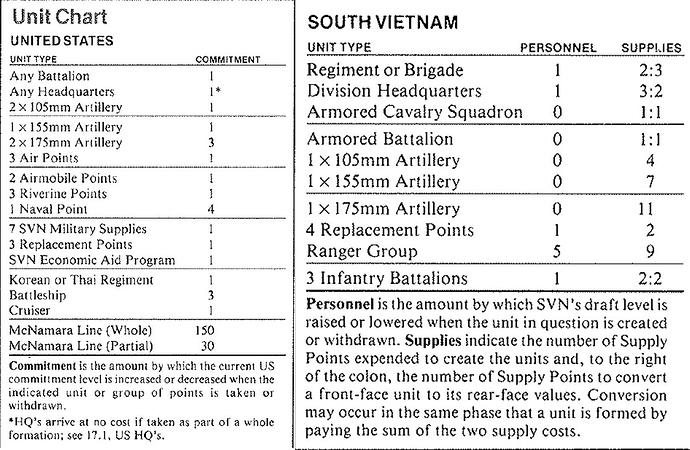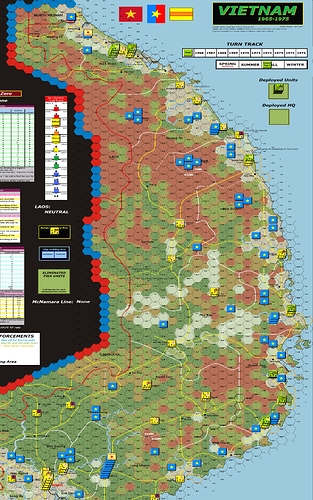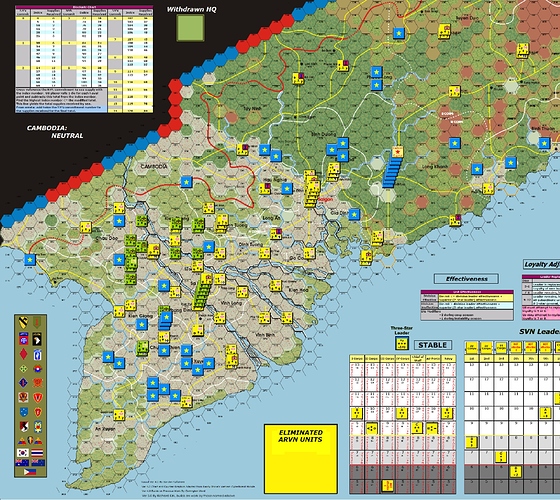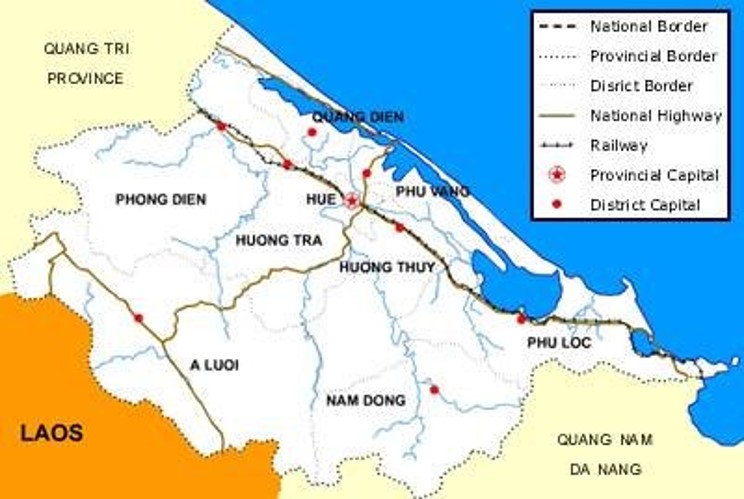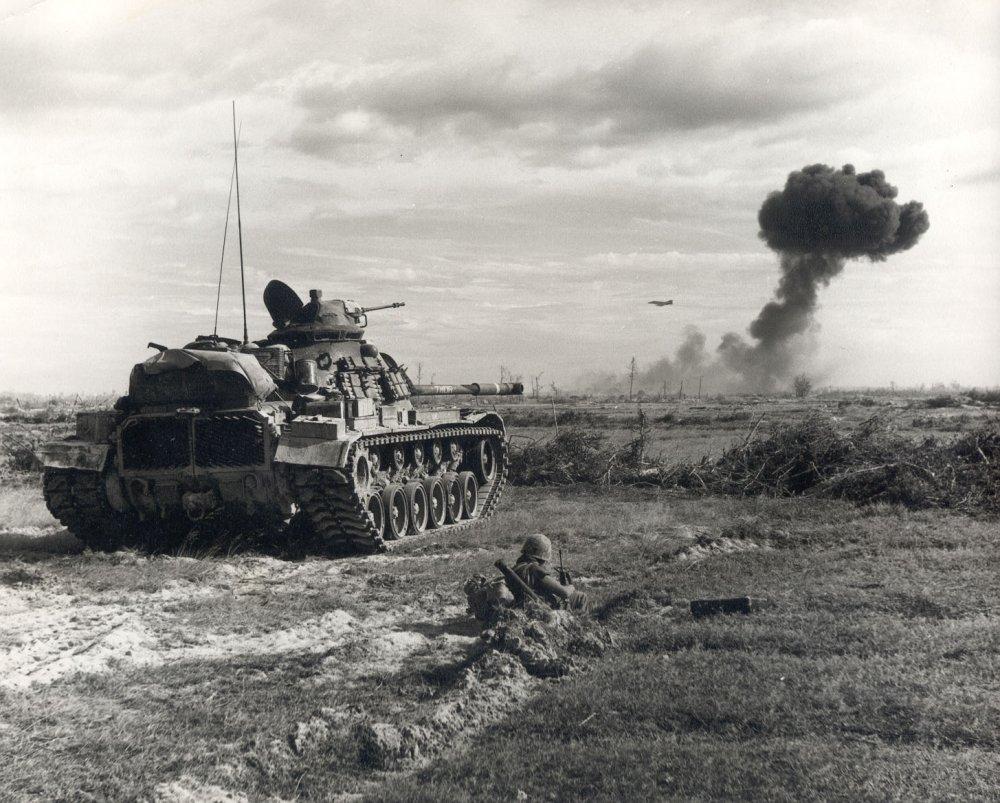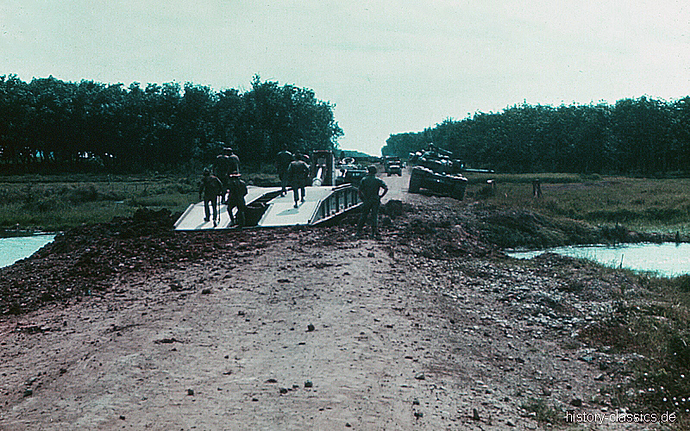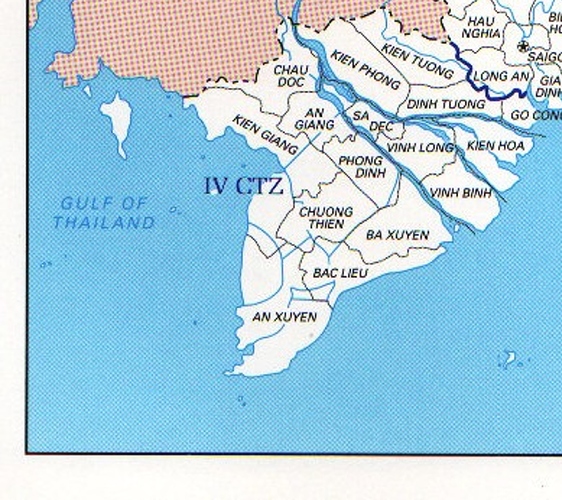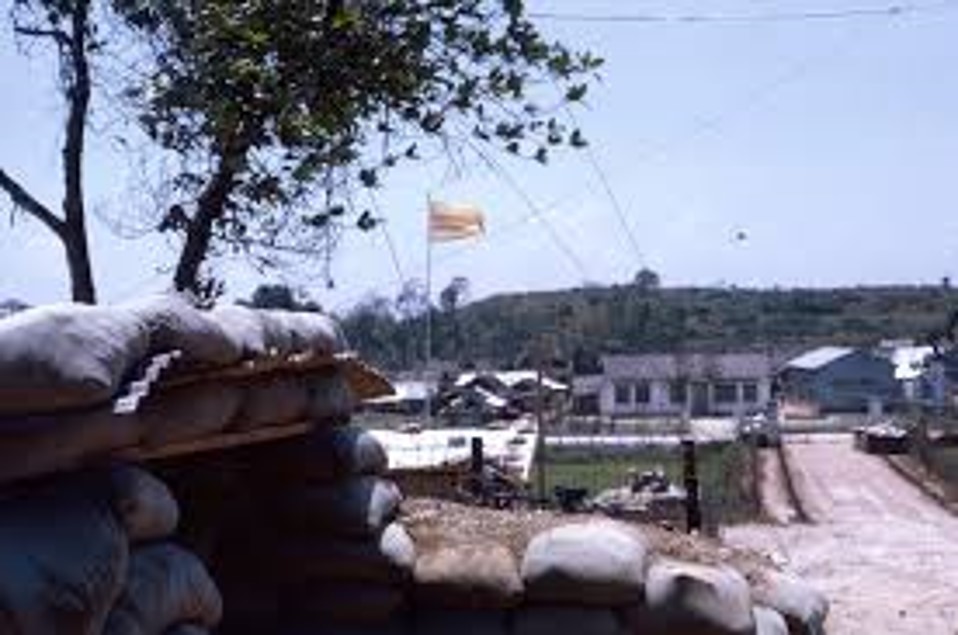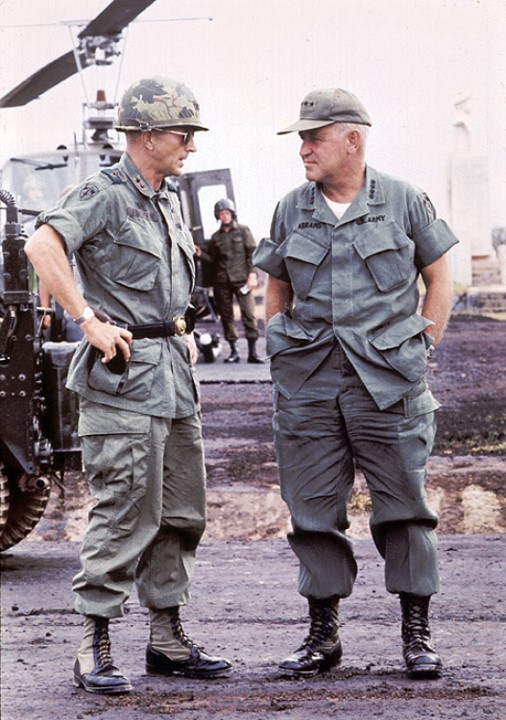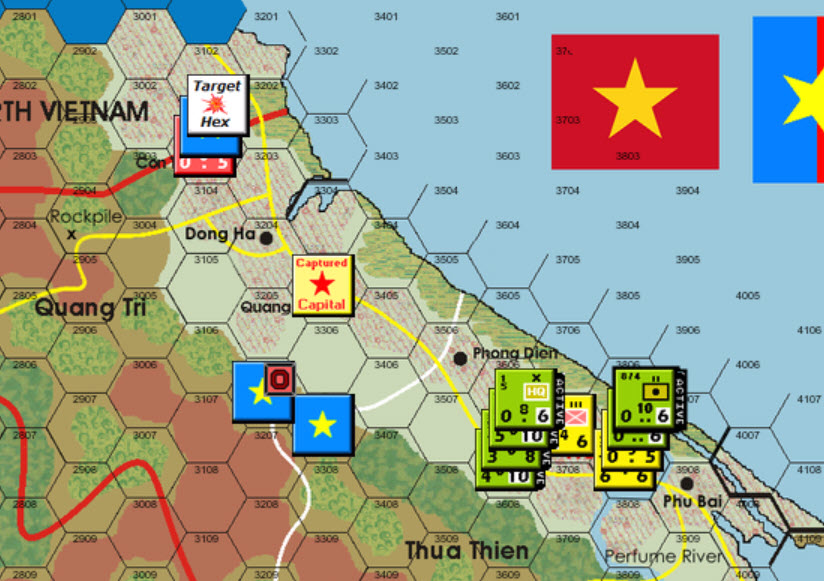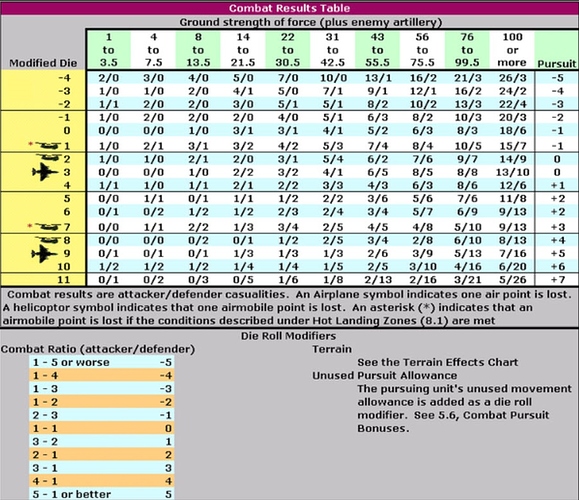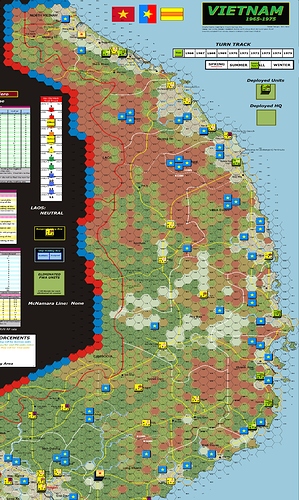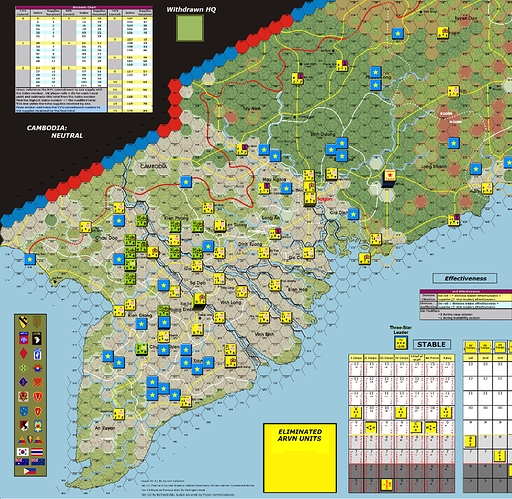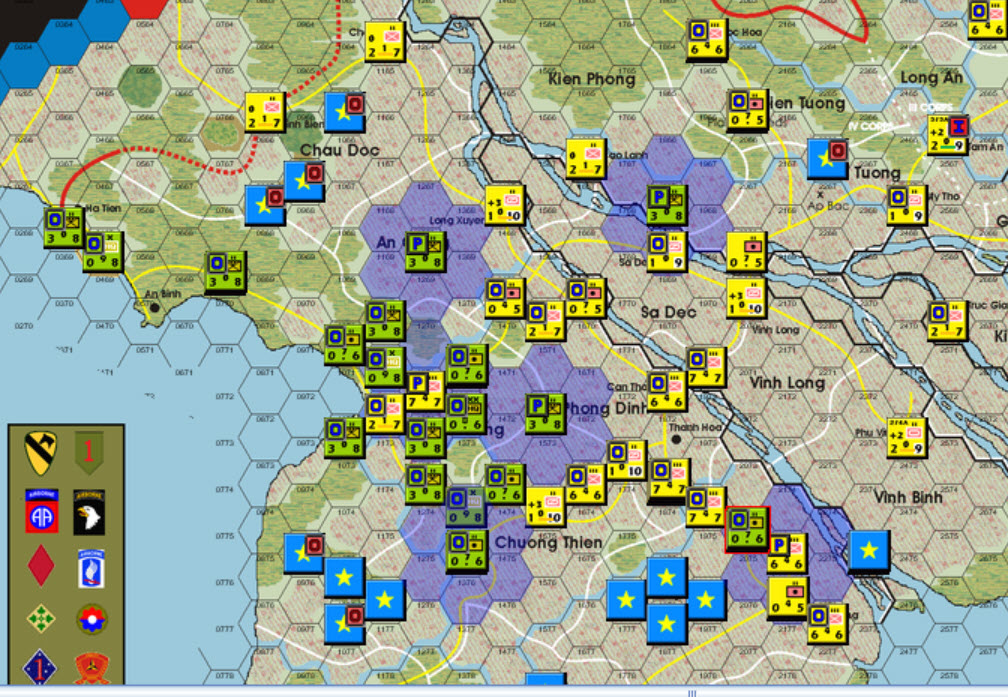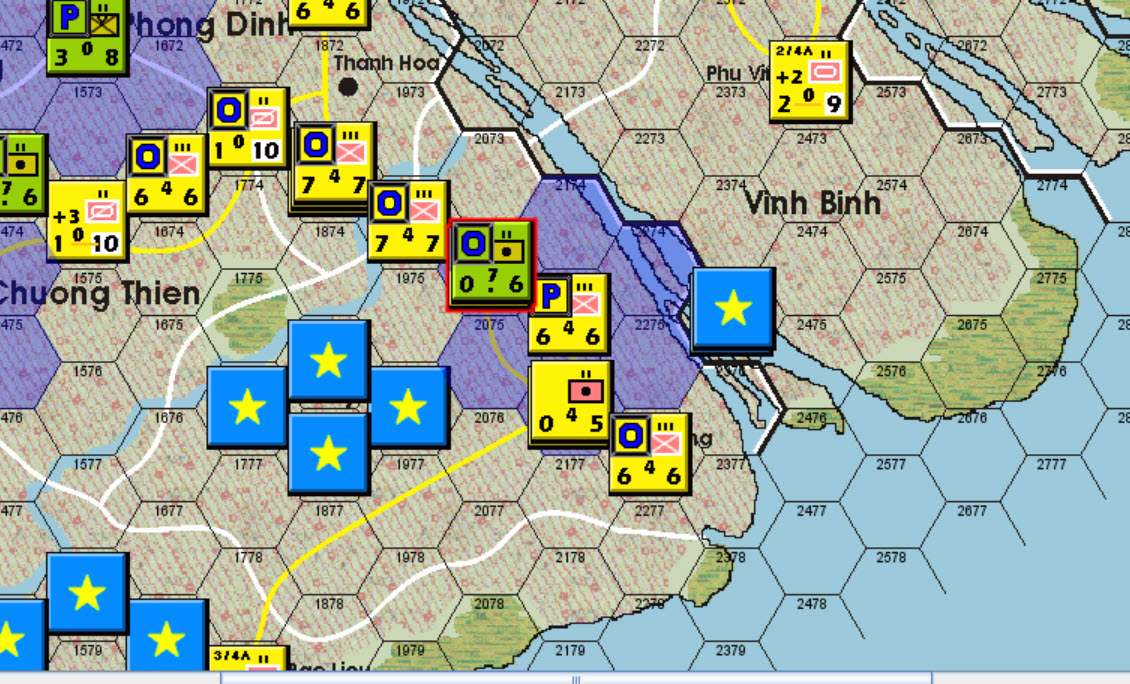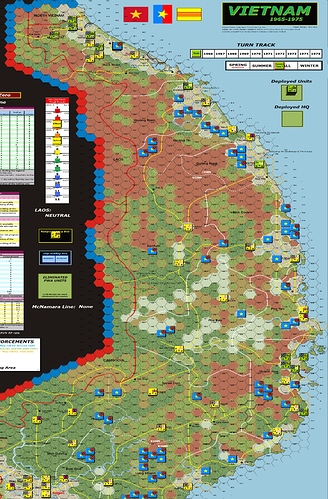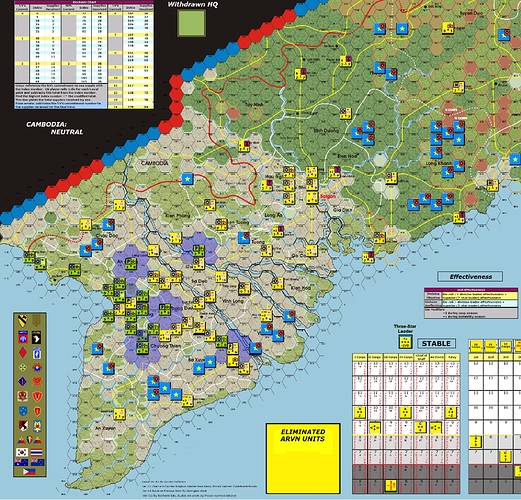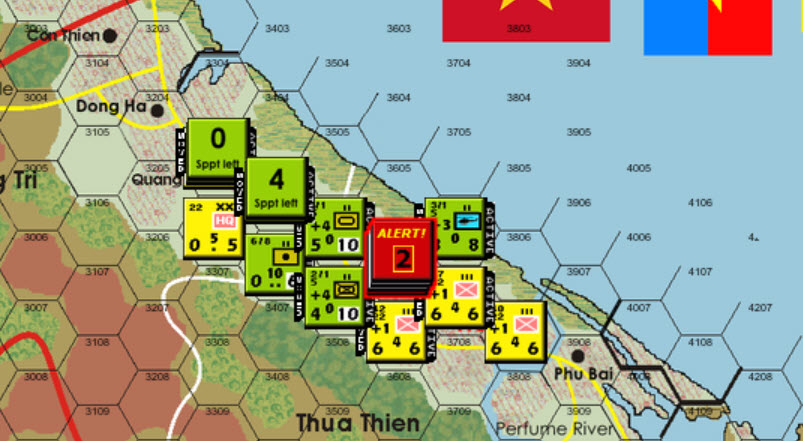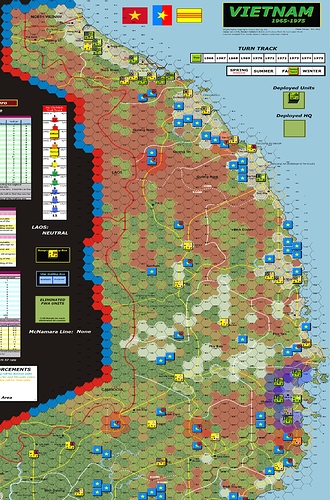Who needs four stars when you have eyebrows like that?
I do think the NLF player is onto something- it’s a lot easier to build up a big cloud of battalions going across the country than it is to build up those regiments and HQs, considering the surge of supplies at the start- it does come at the cost of early pacification gains, but this might be good. Then again, it might not be.
The thing about the big clouds of battalions is that they’re a lot easier to clear out of anything, and there’s less to keep the FWA player honest in his sweeps- you’ll see a lot more ranger use and smaller-scale ops to get more coverage if the FWA sees that many enemy counters.
What war? It was simply a conflict that we were involved in.
They are quite a dominating feature, huh? Emphasizes the seriousness of demeanor. And then ramrod straight, razor creases, short back and sides (not a high and tight or anything like that; that would put off civilians, better to have a slightly softer look that says, “professional, but approachable.”). I mean he looks every bit the part of a General from central casting. I bet he plays that part well.
That’s the key. In another match as the NLF, Curt attempted an even lighter commitment strategy than I am, and I went strong. Half of what I was doing, aside from grabbing Capitals and beating on the ARVN (I popped one or two ARVN regiments whole after bleeding out his Replacement Points in Fall 1965), was trying to get him to do what he didn’t want to do. Which was increase commitment beyond a dribble level of commitment. Part of that was his wanting to delay the possibility of Offensives as long as possible.
So I doubled down on that strategy and launched several" Offensives" like the above (not real-deal Offensives in game terms when US Commitment reaches 150, the NLF can launch Offensives like Tet, and the number of attacks made sap US Morale) but Offensives designed to make him up Commitment faster than he wanted to.
And I had my fun, but started to fall behind the Pacification battle early, which tapped my VC Draft pool of Personnel from Controlled Population early. Also, NVN Morale lags a bit in its increases behind US Commitment, so getting expensive with boutique units early, well, you may not be able to really start building hardcore for another couple of Seasons.
By late1966, IIRC, I was relying on NVN Commitment for Personnel, having used up my VC Personnel Pool… By mid 1967 I was going Conventional with NVA builds, and doing Easter Offensive things by 1969. Yeah, I lost.
This is true, but it’s easier to disperse those guys, and get personnel back as Replacements. With regiments you already bought 3 Battalions, removed them, and then payed another 33% cost in Supply and manpower to Regiment-ize them. Makes you very reluctant to then break them down into battalions to fulfill losses and then disperse/lose them. So you pay a bigger Replacement hit all the time. Also their 6 Manpower constantly gets them on higher casualty tables with the proper application of firepower.
Really there are no right answers. There’s a fine line between just veering from a Strategy because of events of the moment and rigidly sticking to plan that doesn’t work, especially in a game like this where the decisions you make may not bear fruit or lay an egg for a year plus, game-wise. So what you can do, I think, is stick to your strategy, know its weaknesses, and perceive his weaknesses in his strategy and see if you can maximize those while minimizing your own.
And Curt was there to learn that lesson while teaching it. So he wont be doing that now, will he? What do you anticipate from him then?
IDK. We could get into head games, regarding how I’ve played in the past (against other opponents, namely, I usually have preferred tog go bigger early, as the US and then stop short of Westmoreland-esque WW2 theater levels in-country) or how he has played as the NLF in the past (contesting Pacification through presence and then launching Offensives later), but honestly, that way lies madness.
I think, now, I have gone big, but not absurdly so, for the first Season, and he has gone Conventional/Aggressive War early. He’ll have to transition to fight Pacification (very hard for the NLF to win via population control condition, but if not contested, the US can really get the game in hand). The question is when. I think the first few seasons of Pacification/SVN Stability and Effectiveness will tell that tale. To use (hats to @Panzeh’s skillz) poker terminology, the “tell” will be if I observe him breaking down regiments into Battalions or slowly moving from larger to smaller units.
One mistake he made (which he highlighted, while we were talking, we talk about this game a lot while playing) is that while building divisional Arty components, he built Independent Regiments. He would have gotten more long term bang for his buck by buying subordinate Divisional Regiments. Then the Arty would have also helped him far more on defense. Right now, they are just offensive platforms for Bombardment. With the little new commitment he is getting this and the next season, he could either build some Battalions Giap-style to impact Pacification moving forward. He also could try to build a few Divisional Regiments. If I see any of those, that tells me that he is doubling down (for now) on an Aggressive War strategy.
He’ll be looking at what I bring in this next Interphase as an indicator of what I plan to do.
The cat and mouse in this game is just amazing.
Yes it is, and I’m happy to be along for the ride :D
So is your opponent reading this thread too ? XD
If I was alive and college-aged in the '60s, I would have marched against the war, but this thread is fascinating and I’m glad Navarone is putting so much work into it.
Maybe. Certainly initially. Curt just isn’t a social media/forum guy outside of BGG, where is very active in Session reports. We thought it would be fun if I wrote here, him there, and didn’t “peek” after the initial posts, so we could talk strategy, more freely, in-thread. But probably, if he does do a session report series on BGG, he will not begin for a bit. He likes to let a little time pass as the NLF first before starting to write (it’s just his process).
Just to follow up, by the way, here is a very good BGG review/analysis of the game from the pov of an experienced player by Curt.
Turn! Turn! Turn!
Vietnam 1965-1975
1965 Fall Narrative, Interphase Exposition and Fall Interphase Resolution
“To everything there is a season and a time to every purpose, under heaven. A time to build up, a time to break down. A time to dance, a time to mourn. A time to cast away stones, a time to gather stones together."
Take a breath, cuddle something, get a drink, and then please hit play before reading and turn to the maximum volume your brain or household will allow.
The Byrds (lyrics by Ecclesiastes, Adapted by Pete Seeger). Columbia. Released October1, 1965.
In South Vietnam’s Provinces
The downward trend in the provinces continued to favor the communists but overall, the increased presence in the countryside by FWA Forces and Communist heavy-handed (and in some cases, brutal) occupation policies in Quang Tri and Long Khanh backfired somewhat as the populaces there, while acquiescing to their occupiers, didn’t embrace their policies. As well, there was an up-tic of pro-government support in III and IV Corps, as NLF cadres had abandoned the former for the offensive, and US-ARVN Combined Operations had disrupted the VC presence there. However, the downward trend continued, nonetheless a USAID and CIA estimate released September 2, 1965 indicated that the population under government control likely had fallen by 250,000 in the Summer, a decrease of 2%. MACV, USAID and the Agency had muted confidence that the increase in nation-wide morale due to aid programs and the increasing US presence, the clearing of occupied capitals and the disruption of VC efforts in the Mekong Delta likely would stop, and possibly reverse this trend by year’s end.
The Presidio Conference
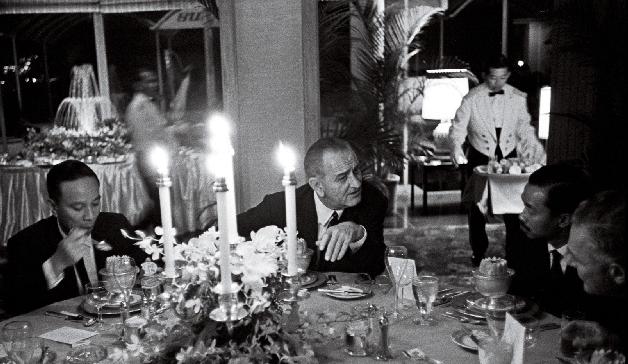
Nguyen Van Thieu and Nguyen Cao Ky, the President and Prime Minister of the Republic of Vietnam, respectively, arrived at San Francisco International Airport on September 6, 1965, accompanied by ARVN Chief of Staff, General Cao Văn Viên. They were escorted to the Presidio for a three-day conference with President Johnson, Secretary of Defense McNamara, Secretary of State Dean Rusk General Earle “Bus” Wheeler, Chairman of the Joint Chiefs of Staff, and several other US military officials. Discussions were held regarding the goals and objectives of the US-South Vietnamese military campaign as well as what aid and social progress could be made in the country to defeat the communist aggression. The Prime Minister and General Vien made clear that a continuation of the unrestricted bombing of the North would enhance the position of the government, hurt the communists militarily and increase the morale of the populace. As well, General Vien advocated a resumption of covert reconnaissance and tracking activities off the coast of North Vietnam. Both were eager to clarify when more US troops might be arriving, given the casualties the ARVN took in the Summer and the gains of the NLF Offensive.
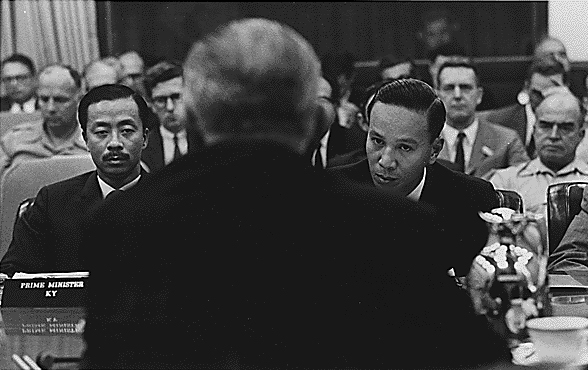
Privately, MACV Commander General Abrams, in consultation with the JCS and Secretary McNamara, planned no immediate Infantry or Armor increases in the Fall, though several US Army Artillery Battalions, three USAF Fighter-Bomber Squadrons of F-105Ds and some US Replacement cadres were bound for theater. The 1st Air Cavalry Division was slated to depart Fort Benning in late November, though there had been delays in detaching and replacing cadres to keep the 11th Air Assault Division intact as a training Division for the Airmobile unit replacements that would be needed for the long Counterinsurgency being contemplated. As well, there was no plan to resume activates off the North Vietnamese coast, as the President was wary that reserve call up and US projection of force in Vietnam might provoke a reaction by the People’s Republic of China. “I don’t want 500,000 screamin’ Chinese coming across the border!”, he told Secretary McNamara, “But if Ky sleeps better in his bed at night if we bomb them [the North], well, fine.”
The South Vietnamese delegation was informed that more troops should arrive by years’ end, and more in 1966, however not in the next few months. More military aid en route should outfit another ARVN Division with the latest equipment, as well as provide enough equipment to outfit an additional ARVN Independent Medium Artillery Battalion. Also, approximately three regiments-worth of US Medium and Heavy Artillery would be arriving in the next week. Air assets would also be increased. Naval efforts off the coast of North Vietnam would not be resumed, however the North would continue to be bombed in force, and these efforts would extend to the Trail in the vicinity of the North Vietnamese entry points into Laos.
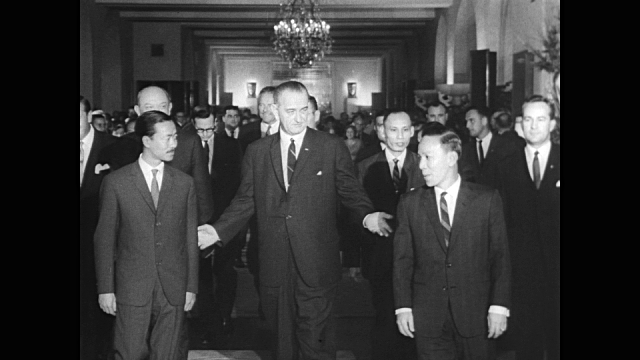
The US representatives also pressed for more democratic reform in South Vietnam in conjunction with limited land redistribution and other social reforms and programs that would aid counter-insurgency efforts in the South. The President promised that economic aid and expertise would continue to arrive in South Vietnam, stating, “If we can build the TVA here, well we sure as hell can make that Mekong deliver electricity to every farmhouse and ranch in South Vietnam!”
Pledge of the Declaration of San Francisco, 1965
United States President Lyndon Johnson disclosed a declaration in a public statement on September 9, 1965. The document content was authored as three parts proposing the intents of the joint governments and their common diplomatic commitment.
I. A commitment by The United States acknowledging South Vietnam was being attacked by guerrilla and jungle warfare pursued by the North Vietnam communist state and promising to aid South Vietnam in opposing this aggression.
II. A resolution by the Republic of Vietnam to combat social injustice, disease, hunger, ignorance, and political apathy, and to promote several economic and social terms for promoting peace and social justice in South Vietnam.
III. The United States pledged to aid agricultural education for new species of corn, rice, and vegetable seeds; fund construction projects for rural Vietnam; aid the Republic of Vietnam in controlling economic inflation; fund, promote and enhance education and health programs; aid in safeguarding refugees from communist aggressors by funding and staffing programs for the care and education for South Vietnamese children and families.
Strategic War
Interdiction of several convoys bound for the Trail were successful as well as bridges at intersections 11 and 15. However, crew reports indicate POL and industrial infrastructure targets have been dispersed by NVN. Unless reinforced, future strikes may reach a limit of effectiveness given available means.
Cable from COMUS2NDAIRDIV to CINCPAC to August 30, 1965.
The 2nd Air Division and Task Force 77 launch nearly all available bombers against targets in North Vietnam. The Haiphong Railyards and Port were hit particularly hard again, as was Vinh’s seaport and industrial center and the city of Đồng Hới, targeting depots thought to house supplies headed south via sea and the Trail, respectively. The strikes were determined to be of limited effectiveness in degrading capabilities given the force applied, as the North Vietnamese began to disperse vital POL stocks to smaller, hidden locations. An attempt to engage what intelligence reports indicated was a hidden fuel depot in Vinh, struck what the North Vietnamese government claimed was a Hospital, and a French Television crew filming a documentary in Hanoi were escorted to the site a week later. As well, the Trail was interdicted, with the Nape Pass and the Mụ Giạ Pass as primary targets. There were no aircraft losses and the strikes were determined to be a success.
The commitment of US Ground Troops and the first reports of US Casualties, the International Press’ mild surprise at the NLF Summer Offensive, the bombing of the Vinh Hospital and resultant footage released by the RTF to other networks internationally, led to an increase in protests in the United States against US involvement in the conflict. A peace march was held in San Francisco from Market Street to the Embarcadero where Joan Baez and Pete Seeger hosted a “Free Folk Peace Concert” where Peter, Paul and Mary and a visiting Donovan also performed. There were also organized peaceful protests at Columbia and Brown Universities. As well as a march on Pennsylvania Avenue organized by Concerned Clergy for Peace and American Physicians for Peace, with Dr. Benjamin Spock a prominent speaker.
The suspension of US covert activities off the coast of North Vietnam hampered US interdiction efforts greatly. CIA estimates indicated that supplies by sea reaching South Vietnam may have reached a new high, estimating that more than 1,000 tons may have been received by PLAF logistics units in South Vietnam via the ocean route.
South Vietnamese Politics
Prime Minister Ky and General Vien, days upon returning from San Francisco, attended a meeting with General Abrams and Ambassador Taylor where they were presented with evidence of intrigues to overthrow the government by II Corps Commander Lieutenant General Do Cao Tri and III Corps Commander Lieutenant General Nguyen Bao Tri. Their removal was recommended. General Vien was eager to be rid of the latter, but Ky prevaricated due to his family connections. They were of opposite opinions, regarding Do Cao Tri. General Vien, felt he could be rehabilitated if courted, and valued his military competence saying, “There are worse men available. At least I know what he can do.” However, Ky leaped at the opportunity, seeing the US evidence as a trump card to overcome Vien’s objections. Do Cao Tri was replaced by Lu Mong Lan, a Ky loyalist. Nguyen Bao Tri was informed of the meeting by private informants possibly impacting his loyalty to the regime. As well, Ky intervened on behalf of Nguyen Huu Co, the 5th Division Commander and Nguyen Van Chuan, the 7th Division Commander, as Vien wanted them relieved for incompetence during the NLF Offensive. Ky’s actions, taken for political and possibly venal reasons, created a small rift between him and Vien, as well as officers aligned to Vien. The delayed impact of the Summer’s USAID program deliveries and personnel, and the arrival of those for the Fall season, combined with the tangential economic boost and direct military effects of the increasing US Military presence in the country boosted South Vietnam’s morale, according to provincial USAID adivisors.
North Vietnamese Politics

In Hanoi, the continued bombings of the North and the successes of The Summer General Offensive and Le Do Uprising 1965 increased the Politburo’s overall resolve to continue to increase it’s military commitment to the conflict, as more Soviet and Chinese aid was promised to be forthcoming. However, the losses incurred and the failure of the Offensive’s results to meet the rhetoric of Lê Duẩn’s Aggressive War faction seemed to give the upper hand to Giáp’s Revolutionary War faction. The NVA 1st Division was withdrawn North of Vinh, possibly to be broken down into cadres to join the struggle in the South, leaving only the Divisional Artillery in Con Thien. As well, several PLAF Regiments in South Vietnam appeared to disperse into composite Battalions, preparing to engage in protracted Revolutionary War in he Countryside, notably, 4 identified regiments in II Corps, 2 in Xuan Loc and one in the Southern Delta.
US Plans
In South Vietnam, on September 9, 1965 the US 2nd and 8th Battalion (BN)/12th Field Artillery Regiment (FA), the 6th BN/16th FA, the 1st BN/27th FA, the 2nd BN/31st FA and the 2nd BN/35th FA, all medium 155mm Howitzer Battalions, arrived in Cần Thơ in IV Corps. As well, the 8th BN/4th FA and the 6th BN/8th FA, 175mm Artillery Battalions arrived in Hue. Three USAF squadrons of F-105Ds and 3 replacement battalions of US Army troops arrived in Bien Hoa. Equipment arrived in-country to outfit and augment the entire 18 ARVN Division under its new commander, Major General Le Van Hung, and 14 Battalions-worth of replacement cadres were outfitted. One Battalion of ARVN Artillery were upgraded to the latest US 155mm howitzer models.
As Abrams prepared US and ARVN Forces for partnered operations in the Fall, the deliberations revolved around the retaking of Xuan Loc city in Long Khanh and Quang Tri Province as a whole. The PAVN withdrawal from the Nothernnmost province of South Vietnam made the latter a distinct, achievable possibility, much earlier than he or his Staff had anticipated. The recapture of Xuan Loc would be a bridge too far, unless ARVN elements could handle the job with minimal US assistance. The focus would still be on IV Corps, completing the clearing begun in the Summer.
NLF Strategic Shift
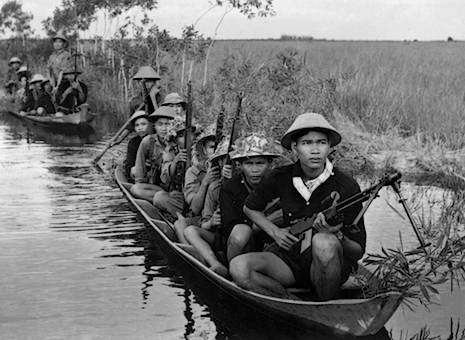
The Viet Cong appeared to increase its presence in II and III corps overall, especially in War Zone C, War Zone D and Kontum Province, all historically VC Controlled Zones, that had been emptied for the Summer Offensive. The NLF appeared eager to retrench, reclaim familiar terrain, and possibly move to harassment and ambush tactics after the limited gains of Summer 1965’s exertions.
Interphase Resolution (and Exposition)
Please hit play before reading and turn to the coolest, mellowest, whiskey-on-the-rocks-tasting volume your brain or household will allow.
Frank Sinatra, “It Was A Very Good Year”. Reprise. #28 on the U.S. pop chart and Sinatra’s first #1 single on the Easy Listening charts in the Fall of 1965 and won the Grammy Award for Best Vocal Performance, Male in 1966.
Vital Statistics
Recordkeeping Phase (an ongoing Process)
Pacification Phase
So, every season, you go province by province and roll for Pacification. On the below chart.
And then you record them here.
The roll is modified in each province by these values.
Every Province in South Vietnam has a maximum and the roll ticks the SVN Control up or down. Every whole number level has a value divided in thirds: 3-, 3 and 3+ for example, then 4-, 4, and 4+. When the total is calculated you add each side’s whole number values, forgetting the “+”’s and “-“’s. That number, adding 70 (for Saigon and the rest of the Gia Dinh Capital Zone) is the SVN Population Controlled. Then that total, subtracted from 460 (the Grand total of SVN’s whole population) is the NLF Controlled Population.
The column the US Player rolls on is shifted Left (bad) if SVN Morale is less than 70. If 70-139, no shift. If 140+, one shift right (good). SVN has 68 morale. I should have rolled for 2 economic aid packages last season, but we screwed up. I rolled poorly (more later in this post) and only got +1 for each. So, no practical game effect.
The chart rewards whatever way the province is leaning already, in its curve. The US can’t do anything to practically aid pacification other than improving SVN Morale and sweeping NLF units out of Provinces. Some finer notes: if there is an odd number of NLF Units in a province and on non-town, capital or cultivated hexes, the number is rounded down. So, one unit in a jungle, for instance has no effect. 3 units in a Jungle are a -1, and so on. Also, this is the only time where the US gets to “have a say” about where Mr. NLF-man is located if he is on a provincial border hex. The US can declare one of those to be in a province of his choices. In all other game situations, whether that border is a provincial one or an International one, the NLF player decides.
I lost 7 population to 210 and the NLF gained to 150. Pacification is just rough for the US in every game-beginning situation. It’s the way it is. The country was falling apart. As well, you must arrive in country in entry ports, limiting operational reach,and you don’t have all your “stuff” yet. Against competent NLF play he is either going to spread out and try to sink Pacification country wide in areas or do what Curt did and smash and Grab some pacification mods in Aggressive War. But in many, many games playing both sides, I have never seen the US increase or stay even in the first Pacification Phase. The best I have seen was in a game against a new player playing the NLF ( who I was really advising and being collaborative with on the first turn, helping him to make the best moves and decisions possible). He set up most of his units on roads (I tried…) and I did about a billion security operations and a few Search and Destroys and CLEARED THE ENTIRE COUNTRY OF VC UNITS except for one in Kontum, One in Tay Ninh, and One in Phu Yen, none in cultivated, so there were no negative modifiers.
I went down from 217 to 214.
Average is about 6-7 against competent play. 4-5 means the gods are with you. 10 is bad. 15 a disaster. Where and when luck intervenes has a lot to do with how rolls go. In Log Khanh, where Curt stacked the Capital, I rolled a 9, mitigating the damage, and I only went down by one whole p[op point (3 levels). In Chau Doc in IV Corps where I swept and destroyed concentrations and worked hard to get a -1 modifier only, I rolled a 4. Down one whole pop point (3 levels). To everything, turn, turn, turn, there is a Season, turn, turn, turn.
So ultimately, I was…Ok…with the result. Bearable. I always want more, but this wasn’t a disaster or even bad. Three more seasons of that, and we’ll have problems.
Strategic War Phase
A. Mission Declaration Segment: I declare what I want to bomb, North Vietnam (Restrained or Unrestrained) and/or the Trail and how many Air Points I allocate. I allocate 22 of my 31 to Pound the North Unrestrained and Unflinchingly. Hamburg, baby. This is a war, not a game-theory calculation.
B. Strategic Bombing Segment: Still no NVN Air Defense built. No Trail Improvements have been made (he’s been buying Artillery to pound me and doing Offensives). rolled a 1 1for 22 Air Points conducting Unrestrained Bombing of the North. You take the number of Air Points and cross reference to the Row that corresponds with it given the low (‘0”) NVN Air Defense Levels at present. That’s row 10. I rolled a 1. Row 11. I had a 50% shot at 2 and a 50% shot at 3 Commitment destroyed. I am glad I guaranteed a minimum of 2. 2 NVN Commitment lost. Then I rolled a 1d6/2 (rounded down) +1 for its harm to US Morale. Rolled a 5/2=2+1, -3 Morale. No losses when Curt rolled again to see if I lost any Air Points. SVN Morale gets boosted +4 to 72 ( Important! ). Then I roll for 8 Air pints against the Trail (which is fragile, 1 hit, and he goes from 9 supplies per commitment point to 8 per). I am on Row 5. Whatever I roll will do 1. I hit the Trail, degrading it. Curt Rolls again, no losses.
C. Blockade Segment: 7 NVN Commitment was sent. That puts him on row 107. I have squadduch, nada, nuttin (choices). So that is a base 42 Supplies for him, =x2 the base commitment sent, (14) = 56 Sea Supplies.
D. Trail Status Segment: Status is one below optimal. Dinged.
Politics Phase
A. SVN Officer Replacement Segment: I must attempt to Mr. Incompetent and Absolutely Disloyal in II Corps. I succeed on a 5. Replaced by A0 with a 9 loyalty. Better. I opt to just do Mr. Totally Incompetent and Very Disloyal in III Corps. Failed on a 7. He grows more Disloyal. but no other ill-effects, though he’ll probably be Pro Coup After the Coup Roll. I try to replace the crappy 5th and 7th Division Commanders and roll a 9 and 11 respectively. They grow more disloyal and their (1 Armored Cav Squadron) Divisions are ineffective. Big Whup.
B. Coup Determination Segment: You roll 2d6 and compare it to the Two Star Loyalties. If the roll is less than their loyalty, they are Loyal. Same as their Loyalty, they are Wavering. Greater than their loyalty, they are Pro-Coup.
If there are more Pro-Coup Leaders than Loyal Leaders, there is a Coup. The Three Star gets put back in the Three Star pull and a new one is randomly pulled (it could be the same guy). The loyalty of every Loyal Two-Star Leader goes down by one. The US takes a -3 Morale hit and the SVN take a -8 Morale hit. Coups are bad.
If the Wavering and Pro-Coup Leaders combined are equal to the Loyal Leaders, the Government is Unstable. The US takes a -1 Morale hit and the SVN take a -3 morale hit. Unstable sucks.
If the Loyal Leaders Outnumber Wavering and Pro-Coup Leaders combined, the government is Stable. Lower the Loyalty of Pro-Coup Two Star Leaders by 1.
I rolled a “9”! Whew! I guess a lot of the Senior Command don’t like this “Land Reform” talk. Mr. III Corps now wins the new title of Mr. Incompetent and Absolutely Disloyal, his loyalty going down by one because he was Pro-Coup and the rest of the command told him to suck eggs. The two who are wavering worried me. If I can replace Mr Bobo next turn, then My No-Coup number will likely stay “9”
C. SVN Morale Adjustment Segment: You implement and calculate all the Morale adjustments for the SVN first. I am at 72 (up from 68 -after those two wimpy economic aid programs belatedly implemented- from the Unrestrained Bombing of the North). -2 for KY and -1 for Population level and then a large +10 for the 20% of new US Commitment last Season. 79 morale. This is good. But with Ky giving me a -2 each season and population still bleeding me, I’ll keep bombing and/or Economic Aid-ing until I get to a healthy Coup/Unstable-proof level.
Leader Loyalty Adjustment Roll-Now I roll on this table to see what wackiness happens with the ARVN Factions:
I roll, a 4! Sigh….all the C faction are annoyed with Ky. 3 Division Commanders (one who is on his way out) and worryingly the Chief of Staff, down to a 9. This is a very important dude. He is competent, and all units under his command are auto-effective based on the numbers. I need him. Stay loyal, General Vien! You are loyal, ramrod straight, and care about your country (he really was, one of the best, all the way around, that they had). Hang in there!
Morale Calculations
D. US Morale Segment: we already went down to 515 from 518 because of the Strategic Bombing. Now we are: -2 for US New Commitment of 16-25 and – another 5 for every portion of 5 above that (-5). -7 total. US Morale 508. Bringing in large amounts hurts.
E. NVN Morale Adjustment Segment: They go from 15 to: +5 if Morale below 40, because they are dedicated communist revolutionaries who know eggs have to be broken to make an omelet, +3 for US Commitment 51-75, and +10 (like SVN) for US New Commitment last season. New Morale, 33. Note that 50 New Commitment for the US is like a magic number for the US. The SVN can never benefit form higher than 20% of 50, but the NVN can.
Recruitment Phase
A. US, ARVN and FWA Placement and Withdrawal Segment
Withdrawals come before Placements. Anything Withdrawn can’t be placed that same segment.
US
Withdrawals: None
Builds: 23C (US Commitment 98, New Commitment now 23).
42 ARVN Supply (6C)
2 Economic Aid Packages (2C) – I roll a 1 and a 3 for each /2 round down +1. A 1 and a 2, 3 total added to SVN Morale, now 82.
6 US 155mm Artillery Independent Batteries (6C) (6 in Can Tho)
2 US 175mm Artillery in Hue (3C) (8/4, 6/8).
9 US Replacements (3C)
9 Air Points (3C)
ARVN
Withdrawals:
7th Division Cav from Qui Nonh (removes leader)
Builds:
1 Left Over, +5C for 42 = 43 Supply.
ARVN Draft at 53.
28 Replacement Points (7P/14S)
Build 18 ARVN Division Augmented in Saigon ( NOTE-Under the Chief of Staff ) – 4P/21S
Build 1 ARVN 155 Artillery Battery in Can Tho – 7S
Build 3 Division Armored Cav in Qui Nonh (1S)
Cost: (11P/43S).
End: ARVN Draft – 64, 0 Supply.
B. NVA and VC Placement: Curt places a lot of stuff I can’t see. What I do see are a lot of withdrawals. The Regiments of the 1 PAVN Division are removed. He gets 9 Commitment reduced from current levels.
C. Infiltration Segment: There isn’t anything o the Ho Chi Minh Trail in terms of units that can move on it. We’ll save this for another day.
D. Offensive Declaration Segment: Costs 10 NVN Commitment and can only occur if US Commitment is 150 or higher. We’re not there yet.
Curt sends file to me, I start a Vlog to record one roll to complete this diary entry.
Unit Status Phase
A. US Organizational Segment: I can alter my Brigades’ deployment Profile if all elements are stacked together. I do. Based on Curt’s builds (we’ll see maps in a second here) I turn the 1/5 Infantry (Mech) Brigade.
From this Road clearing, NVA-Huntin’ Bringer of Pain:
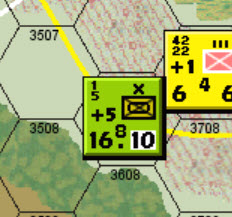
To this:

A versatile Battalion grouping with great Brigade dedicated 155s (all in that hex next to the ARVN).
B. ARVN Effectiveness Roll: I roll 1d6 On the below table and compare with my current Leaders. This is the big enchilada, who can do what for the next two loooong game turns of Fall ’65 for the ARVN.
Also I have to roll less than or equal to a Corps commander’s rating +3 or all those independent Battalions in his Corps area are Ineffective. Ineffective means they basically can’t move and do nothing all Season.
I roll a 1. As good as it gets.
Watch out NLF. Safeties are off.
Vital Stats at Interphase End
Support at Interphase End
I and II Corps at End of Interphase. Note Curt’s increase in II Corps, sprinkling the coast and building in Kontum and the area near the Cambodian Border in III Corps. And a lot of Regiments broke down everywhere. I guess Giap won out. No double-down on Aggressive War for Fall.
III and IV Corps at End of Interphase. Lots of Firepower just arrived in IV Corps. And the 18 ARVN and the ARVN Marine Divisions are ready to handle Xuan Loc.
“But now the days are short; I’m in the autumn of the year. And now I think of my life as vintage wine from fine old kegs. From the brim to the dregs. And it poured sweet and clear. It was a very good year."
Next: What will Fall Bring? Will IV Corps be cleared? Will Quang Tri be liberated? Xuan Loc? What surprises do the NLF have?
By the way, if anyone has any questions about the game or the narrative: rules, why who did what, what’s happening in the History, stuff about the music, really anything, feel free. It won’t disturb or “clutter” anything, and the initial post will be updated with bookmark quick links from time to time. I’m happy for this to be an interactive, discursive experience. If I wanted this diary chiseled on impenetrable stone, I would have blogged it. Talking about stuff here, well, it’s fun.
Your music choices for this are fucking impeccable. It makes me remember my growing understanding of what was happening when I was a kid. The Vietnam era was my political awakening. Thanks for this @Navaronegun
Well, thank you very much, Rich. You know me well enough to know I am a pretty eclectic audiophile, so I really ponder and agonize over those until I find the right one.
My rules are that it has to be current (either in performance date, release date or date on one of the charts) ; it has to pertain lyrically somehow to what is happening in the narrative (even if, like “The ‘In’ Crowd” it’s an instrumental based off a song that had lyrics) and it has to make a good “soundtrack” to the written narrative. Oh, and I have to dig it. And I need an “A” side and a “B” side to the narrative. Period format tribute.
That usually means longer songs, so I usually pick long versions or interesting alternative takes, because the 1965 standard is the 2m30s single a lot of the time (I mean AM stations had issues with the Album version of “Help Me, Rhonda” because it was a whole 3:17 in length, the damn Philistines!).
But within all that above, I also try to be eclectic. Everything wasn’t Beatles, or British Invasion, or Blues. Or Motown. There’s Stax, Atlantic/Fame, Jazz, Country (really good Country too), Folk. Easy listening/older styles (like Frank that were very popular, of that time). And they were all changing and becoming more mature art forms, in all genres, not just Rock and Pop. Imagine listening to say, Johnny Cash “I Walk the Line” in 1964 and then getting in a time machine to 1968 and listening to any track off of “Live at Fulsom Prison” and your mind would be blown. I mean if we watched some crappy documentary on the era you’d never guess that you’d be as likely to hear “It Was A Very Good Year” anywhere you went as much as say “Help!” in 1965.
Anyway, thanks for appreciating it.
All go to one place; all are from the dust, and all turn to dust again. Who knows whether the human spirit goes upwards and the spirit of animals goes downwards to the earth? So I saw that there is nothing better than that all should enjoy their work, for that is their lot; who can bring them to see what will be after them? - Ecclesiastes
If you feel like you need material @Navaronegun this gentleman here can have you covered when it comes to one hit wonders on local radios that recorded a 45rpm and that was about the extent of their careers
the companion blog, funkycorners16 is pretty good too.
Farewell, Angelina
Vietnam 1965-1975
Fall 1965 Narrative, Operations Exposition and Fall Operations Resolution
“Farewell, Angelina, the bells of the crown are being stolen by bandits, I must follow the sound. The triangle tingles and the trumpets play slow. Farewell, Angelina, the sky is on fire and I must go.”
Take a breath, hug a pet or human, and then please hit play before reading and turn to the most introspective volume your brain or household will allow.
Joan Baez “Farewell, Angelina”. Written by Bob Dylan. Released October 15, 1965.
Revolutionary War

As Fall began, it became evident that General Giáp’s exhortations to resume Revolutionary War, abandoned since the Buddhist Crisis began, in 1963, had become the dominant view in the Politburo. Large concentrations of PLAF Forces used in the Summer Offensive, had broken down into component Battalions or had reinforced Provincial Forces and Local Force cadres, abandoning most coastal areas and occupied Xuan Loc for inland base areas.
In Quang Tri Province, a concentration NLF Battalions were dispersed and the remainder had withdrawn West to the mountains. As well, the Artillery of the 1 PAVN Division remained in Con Thien, just south of the Demilitarized Zone.
Operation Metz/Operation Chim Ung Tự Hào (Falcon Proud)
The 1st Brigade/5th Infantry Division (Mech) launched Operation Metz and the 22 ARVN Division, launched Operation Chim Ung Tự Hào (Falcon Proud) in Quang Tri Province, respectively, in early September 1965. These independent, but coordinated operations were intended to clear the populated regions of Quang Tri Province of NLF units, and prevent the infiltration of enemy units into Thua Thien Province. MACV had accepted risk in I Corps, and the Staff expected the NLF to reestablish/reinforce its presence in Southern I Corps, but given the PAVN withdrawal from Quang Tri, sets as it’s goals for the Fall to clear Quang Tri and prevent any enemy gains in Thua Thien.
On September 5, Operation Metz was launched, targeting the 1 PAVN Divisional Headquarters and unknown VC elements in Con Thien. The composite Armor and Mechanized Infantry battalions of the 1/5 advanced to the South and the Northeast of Con Thien, respectively, while the Infantry battalion advanced into Con Thien, the latter two units straddling the Demilitarized Zone. The Brigade Artillery and the 175mm guns of the 8 Battalion/4 Field Artillery (FA) Regiment established Firebase Greeley 5 Miles Northwest of Dong Ha and supported Operation Metz from that location, providing interdiction fire to pin the NLF and providing general Ground Support Fire, aiding the attack. On September 7, the attack was launched. The US forces suffered minimal casualties and the 1 PAVN headquarters was destroyed, though the now identified 20 PLAF Battalion retreated into North Vietnam, 13 miles north of he DMZ. After this, the 1/5 (Mech) advanced into defensive positions along the DMZ, within Defensive Artillery range of Firebase Greeley, their intent to interfere with any potential NLF movements into South Vietnam.
The 20 PLAF Battalion reinfiltrated South Vietnam, however, and joined a grouping of NLF Units in the mountains approximately 25 miles Southwest of Phoung Dien. Artillery fire struck the 2/1/5 (Mech) and ARVN Provincial Forces in the now-reoccupied Quang Tri city on September 12 from this location, and this prompted the 22 ARVN Division to launch Operation Chim Ung Tự Hào (Falcon Proud) on September 15. The Division, minus the 40 Regiment which was garrisoning Hue, launched a combined air and ground assault, supported by ARVN Rangers and 175mm guns of the US 6/8 FA. Despite pinning the enemy forces with interdicting fire, the NLF (now identified as the aforementioned 20 PLAF Battalion, the 5th PLAF Divisional Artillery Regiment and the 2 Thua Thien Provincial Battalion) formed an assault column for retrograde movement, attempting to move through the 6/8 FA contingency firebase. The NLF assault caused no casualties to both forces and the NLF retreated towards the coast, 5 miles South of Phuong Dien and 3 miles East of National Route One.
Operation Metz II /Operation Chim Ung Tự Hào (Falcon Proud) II
The 20 PLAF Battalion and the 2 Thua Thien Provincial Battalion then moved into southern Thua Thien Province, into mountains near the Laotian border, approximately 40 miles West of Da Nang. On September 30 the entire 1/5 (Mech) and the 22 ARVN Division (minus the 40 regiment, which had moved South), supported by the 175mms of both the 8/4 and 6/8 FA conducted a combined ground and air assault against the 5 PLAF Divisional Artillery, 5 miles South of Phuong Dien. This unit was destroyed, at the cost of approximately 150 ARVN and 10 US Casualties. The tactical advantage gained by the operation allowed these elements to continue south, to the Tua Thien/Quang Nam provincial boundary, to prevent any Viet Cong infiltration north from the latter province.
Operation Bastogne/ Hổ Giận (Angry Tiger) III and IV
Operation Bastogne/Hổ Giận (Angry Tiger), begun in the Summer, continued into the Fall as the 101 Airborne (Air Assault) Division and the 1, 23, and 25 ARVN Divisions launched Bastogne/ Hổ Giận (Angry Tiger) III on September 10, which attempted to continue to disrupt NLF pockets in the Delta and cordon these units into pockets that could be reduced, and preventing the NLF positions from being able engage in mutually supporting operations.
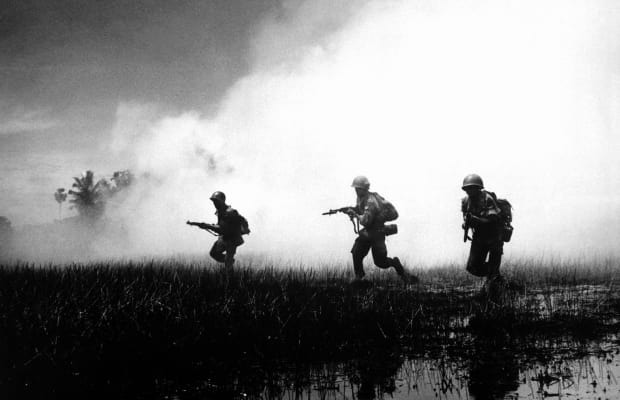
However, by September 28, a coastal gap appeared in a US/ARVN cordon in Southern IV Corps, allowing at least 5 NLF units to escape North of the Southern Distributary Channel into Vinh Long Province. This caused a change in plans for Bastogne/ Hổ Giận (Angry Tiger) IV. Rather than reduce the pockets with this Fourth Phase, pockets would be constricted in Southern, Eastern and Northern IV Corps, with the goal of then reducing them in Winter; the NLF having been restricted to a small portion of the overall Area of Operations. By October’s end, enemy units were isolated into four pockets with two NLF units in each of Chau Doc, An Giang and Vinh Long Provinces, three in Bac Lieu Province and five in Kien Hoa Province, the latter troubling as it has the largest population in the Delta.
Defensive Posturing Along the Coast and near Saigon
NLF Movements consisted of a retrograde movement into the interior of the country, into rough terrain, followed by reinfiltration into the populous coastal provinces of Quang Nam (4 Unidentified NLF Units), Quang Tin (5 Unidentified NLF Units), Quang Ngai (4 Unidentified NLF Units), Binh Dinh (7 Unidentified units), Phu Yen (3 Unidentified NLF Units), Khanh Hoa (6 Unidentified NLF Units), and Binh Thuan (3 Unidentified NLF Units). As well, large NLF concentrations in Long Khanh Province (14 Unidentified NLF Units) seemed on the verge of creating a new NLF Base area in that Province, near the II/III Corps seam. ARVN Paratrooper and Marine Divisions conducted short sweeps into these areas to disrupt NLF Operations along the edges, but as Southern I, and all of II and III Corps were experiencing the results of MACV’s decision to employ Economy of Force to enable aggressive operations in IV Corps, these operations were of limited effectiveness in inhibiting NLF Freedom of Movement.
The 173 Airborne Brigade (Separate) conducted aggressive patrols in Khan Hoa to inhibit NLF movement into populated areas, but this too was limited in its impact. This NLF coastal presence could not be dealt with effectively without an expansion of ground troops in the region.
Concerns as Fall Ends
With the ending of November, it became apparent that something had to be done soon, regarding the coastal NLF presence or pacification efforts could continue to be degraded. Secretary of Defense McNamara planned a visit to Vietnam in early December to meet with MACV Commander General Abrams regarding Operation Freedom Partner troop levels and bearing potentially troubling news regarding a RAND Corporation study of the NLF, Pacification Efforts and current Military Operations. “The Principal wants us in his office,” Abrams told Major General Seaman, his MACV J3 Operations Officer, “And I think he wants some answers regarding our grades this term.”
Fall Operations Resolution (and Exposition)
Please hit play before reading and turn to the maximum volume your brain or household will allow.
The Rolling Stones. “Get Off of My Cloud”. (Performance begins with “She Said Yeah” written by rockabilly singer Roddy Jackson and Sonny Bono - under the name Don Christy). Released September 25, 1965. In the Top 10 all of October 1965.
The Operations Sequence
“When eating an elephant take one bite at a time” – General Creighton Abrams
What is the Operations Sequence?
For the Season’s Operations, you do this twice, in two Game Turns.
1 – Support Phase -Self Explanatory. The US player make sure all Air, Airmobile, and Riverine Points are all accurate and reflected properly on the record tracker.
2 – Special Operations Designation Phase: US Player indicates all units on Hold or Patrol. Then the NLF Player does the same. “Hold” doubles the combat and support strength of a unit for defense, for the Game Turn, but makes the unit ineligible for any other operations that Game Turn. Units on Hold also have no Zone of Control – ZoC (ZoCs inhibit enemy movement). “Patrol” doubles the ZoC effect of the Unit on Patrol; it really inhibits enemy movement. Any units that do either are Operations Complete (OC) for the rest of the turn. The NLF Player may conduct Strategic Movement later on in the Operations Phase (the NLF cannot do Security Operations or Naval Movement). Ineffective ARVN Units may only conduct Strategic Movement and may only do so in this Phase.
4 – Operations Phase – This is the Heart of the Game Turn. First, the NLF decides who is going to Operate. Then the Operating player may do any of the operations outlined above, as well as:
Search and Destroy Operation (both Players): Basically, movement and then Attack by designated Units.
Clear and Secure Operation (US Player Only): A Search and Destroy, sacrificing some mobility, where the units can end the Operation on Hold or Patrol, at his choice.
Bombardment: US Air Points, US Naval Units or either players’ Artillery Units (that have not moved) may bombard an enemy unit.
Offensive Reserves (US Player Only): Units may join a Search and Destroy or Clear and Secure Operation already in progress.
Defensive Reserves (US Player Only): Units may join the defense against an NLF Search and Destroy Operation already in progress.
Note- any operation could conceivable have all that side’s units and all its support allocated to it. If a Player wants to do that. Your only limit is yourself.
5 – Game Turn Indication Phase: This is Just the End of the Game Turn. This occurs when the NLF Player Declines to Operate, the US Player Declines, and the NLF Player Declines again. Theoretically, every single Unit on Map May conduct/participate in any of the above before this occurs, but they do not have to. If it is only Game Turn One, you go back to the top there and do it all over again for Game Turn Two. When that ends, that ends the Season.
Here is an S & D Operation step by step.
Operation Metz: Target is Con Thien, 1 PAVN Divisional Headquarters and an Unknown VC Unit. 1st/5th Mech HQ, and 3 Battalions, and 1 Supporting 175mm Battalion are activated for a US-Only Search and Destroy Operation. No Air or Airmobile Support.
The BDE HQ, the 8/4 FA BN and the 1BN/1BDE/5 move due South of Con Thien. The 2/1/5 Mech BN moves to the Northeast of the Target. Note that the move costs 4 ½ movement points for that unit, ½ a MP for every road hex, then an extra movement point to leave the VC ZoC to enter to the north east of it. The 3/1/5 Infantry Battalion moves into the Target hex. The Hex is interdicted for -1 using 6 artillery from the BDE artillery’s 8 total. Note that Quang Tri is not Free Fire (I want it to heal in Pacification). If Free Fire, that cost would have been 3. You can Interdict up to -2 which costs 7/14 Fire points. Interdiction makes it harder for the enemy to leave the hex, either during VC Alert Movement or during a retreat, by giving a -1 or -2 MP penalty. My Unit in his hex costs an extra 1 to leave. My surrounding ZoCS cost a -1 MP. So, if he chose to leave after an Alert Roll, it would cost him 3 MP’s plus the cost of the adjacent terrain.
VC (not NVA) May always make an Alert Roll right at this point; after the units are committed to the operation (including, potentially Airmobile and Air points) , and after Interdiction Fires, but before revealing for determination of combat odds. The VC then rolls 1d6 and adds the foot movement cost of the terrain (here, 1 MP). So, if he rolled a “3” he could move one hex into clear or Cultivated terrain. He’d need at least a “5” (+1 to a “6”) to be able to move and then escape “clean” and not be adjacent to me, and that would end the combat. Or he could Move into another hex and face fewer units adjacent. But my Artillery is very long range, he really can’t avoid that. All those are permutations of the VC Alert Roll. And it helps explain why, in the game they are so difficult to bring to combat. It is very resource intensive. Even on a simple Bombardment, they will simply alert and move away, wasting the bombardment. If the VC after the Alert roll, decide to, they can disperse. The Combat unit (s) are removed as “kills” and their ground strength added to their replacement pool. They can always disperse too in response to losses, say, taking a 1 pt loss with a 2-ground strength Battalion, taking the damage with one of those points and adding the other to the replacement pool.
Anyway, this is moot. The VC want to stay and fight and see if they can save the NVA HQ. He doesn’t roll
I know that NVA has 6 Artillery Strength. I assume that the VC isn’t a political Section decoy or it wouldn’t be there. I assume that he’ll be hitting me with 6 Artillery (NVA and VC don’t have “free Fire Zones” and whatnot. The whole country is “Free Fire” to them) and 2-3 Ground Strength Points. 8 or 9 total for odds. So I declare my attack: I have 12 Arty Left, So I use 6 Ground Strength of the 12 I have available to which my net 6 Arty will be added, making 12. With luck, he’ll have 8 and I’ll get on the 3:2 table. No matter what we do, I’ll be on the 8-13.5 Casualty Table, as he will be (if he has a 2 or a 3 Ground Strength).
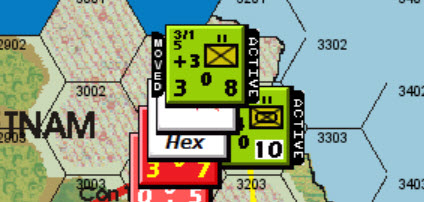
He has a 3. 9 total. I am one short of a 3:2, but I didn’t go up to the 14-21.5 table for casualties.
We are both on the 8-13.5 chart. It is a 1:1 attack, -1 for a town. I roll a 5, -1 to a 4. We each lose one. I get +1 Pursuit for the next round. This is important. If he retreats, he’ll only be able to move one hex with the HQ, into cultivate or Grasslands. And he’ll be adjacent to my Armor or Mech Battalions, which each have an inherent pursuit of +4. So I could do the same attack again, (with as much as 12 Ground, but I’d use 5) and all my artillery (net 9). For odds purposes I’d be at 14 Total for a 3:2. So I’d roll with a net +1 for odds, +1 for Pursuit Result, +4 for Inherent Pursuit = +6. That would really hut him. So, he just kills the HQ for his loss and retreats the Battalion far into North Vietnam. I take 1 US replacement loss. Then I get to pursue in Movement points based on +1 to every unit’s inherent values. The Artillery and the HQ can’t pursue (unless they are Airmobilized). So, I occupy Quang Tri with the Mech, leave the Infantry in Con Thien and Move the Armor out West to inhibit any moves he might make out there. They are all in rage of their BDE Artillery and that Independent Artillery, so, If attacked, 9 net (18 halved, no Free Fire) points of death from Above will aid each in a potential defense.
End Operation
Support at Start of Operations
I and II Corps at Beginning of Fall Operations.
III and IV Corps at Beginning of Fall Operations.
End of Operation Bastogne III
The Coastal Gap
I and II Corps at End of Fall Operations 1
III and IV Corps at End of Fall Operations 1
Commentary – Curt did what I thought he’d do and transitioned from big unit, Aggressive War to Revolutionary War. Namely create a presence, harass and avoid concentration or contact and attempt to impact Pacification.
I had successes in IV Corps, hampered by a lack of friendly forces which allowed the coastal gap to appear. I was content, in Fall to merely have a chance at increasing government control in IV Corps. He is split up, and his units will be destroyed there in Winter. Or he can withdraw them. Either outcome satisfies me. But that needs to happen next Season. No delays.
Because I need to move on to other things. More problematic was the gut-wrenching appearance, mostly uncontested, of NLF Units on the Coast from South of Da Nang to Vung Tau in III Corps. And I just don’t have the force to do anything about it. Pacification could go very wrong for South Vietnam next Interphase.
My strategy Commitment-wise was to go strong and “set the table” for country-wide pacification in 1966, but accomplish tangible goals in IV Corps, while getting all support and firepower in Place by the beginning of 1966. As well, this would let me come in strong, early, but try too avoid some US Morale penalties (-1 for being at 100 Commitment, -1 for each 5 over 25 new Commitment, etc), by coming in (relatively) light in Fall, after the 50 Commitment Point big kick off in Summer.
This strategy though assumed risk along the coast, and Curt is coming down on the strategy’s vulnerability, but hard. I actually would have preferred he stay aggressive.
Operation Metz II
Commentary – I think, think, mind you, that I can possibly end combat in IV Corps and move to a holding strategy by Winter’s end, but I need to begin that hand off now. Not much else to comment on here. The pacification mods (mostly -1 per unit, as they are all in cultivated) along the Coast worry me greatly. Curt did a classic NLF operational concept there (that I have done in the past too). Migrate to poor terrain inland in the first turn of the Season, and then migrate back to the coast at Season’s end. With the low troop density, I have, I can’t say much about it. Next Interphase’s Pacification and Commitment for both of us will be, as they say, “A Big Deal”.
I and II Corps at End of Fall Operations 2
III and IV Corps at End of Fall Operations 2
Support at End of Season
“The telephone is ringing I say, ‘hi, it’s me, who is there on the line?’ A voice says, ‘hi, hello, how are you?’ ‘Well, I guess I’m doin’ fine’.”
Next: What will happen when McNamara visits Vietnam? What does the RAND study contain? What will Pacification indicate? What will the next stage of Operation Freedom Partner bring to South Vietnam?
By the way, if anyone has any questions about the game or the narrative: rules, why who did what, what’s happening in the History, stuff about the music, really anything, feel free. It won’t disturb or “clutter” anything, and the initial post will be updated with bookmark quick links from time to time. I’m happy for this to be an interactive, discursive experience. If I wanted this diary chiseled on impenetrable stone, I would have blogged it. Talking about stuff here, well, it’s fun.
This is an amazing AAR. I don’t really understand some of it, but kudos on a great job!
Thanks, hopefully as the Diary moves forward, and I give more examples and operational snapshots, the rules and gameplay will become clearer.
A lot of the complexity of Karp’s Vietnam is that it’s a massive game in time scale. It is a huge endeavor to do a game.
Yeah, and that means decisions play out over a long time. So there is a lack of “feedback” on them. And good decisions can still be undone by events and the other guy.


